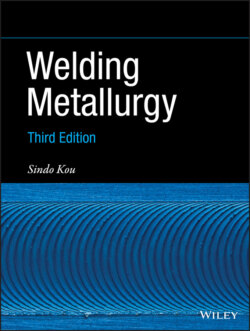Читать книгу Welding Metallurgy - Sindo Kou - Страница 67
2.1.2 Melting Efficiency
ОглавлениеDuPont and Marder [7] studied the ability of the heat source to melt the base metal (as well as the filler metal), as shown in Figure 2.9. Figure 2.9a shows the cross‐sectional area representing the portion of the weld metal contributed by the base metal, A base, and that contributed by the filler metal, A filler. One way to define the melting efficiency of the welding arc, η m , is as follows:
(2.4)
where V is the welding speed, H base the energy required to raise a unit volume of base metal to the melting point and melt it, and H filler the energy required to raise a unit volume of filler metal to the melting point and melt it. The quantity inside the parentheses represents the volume of material melted while the denominator represents the heat transfer from the heat source to the workpiece.
Figure 2.9 Melting efficiency: (a) transverse weld cross section; (b) lower heat input and welding speed; (c) higher at higher heat input and welding speed; (d) variation with dimensionless parameter ηEIV/Hαv.
Source: DuPont and Marder [7]. Welding Journal, December 1995, © American Welding Society
.
Figures 2.9b,c show the transverse cross‐sections of two steel welds differing in the melting efficiency [7]. Here, EI = 3825 W and V = 10 mm/s for the shallower weld of lower melting efficiency (Figure 2.9b) and EI = 10 170 W and V = 26 mm/s for the deeper weld of higher melting efficiency (Figure 2.9c). Note that the ratio EI/V is about the same in the two cases.
Fuerschbach and Knorovsky [5] proposed the following empirical equation for the melting efficiency:
(2.5)
where A and B are constants, H = H base + H filler, α is the thermal diffusivity, and v is the kinematic viscosity of the weld pool. The results of DuPont and Marder [7] shown in Figure 2.9d confirm the validity of Eq. (2.5). As the dimensionless parameter ηEIV/(Hαν) increases, the melting efficiency increases rapidly first and then levels off. If the arc efficiency η is known, ηEIV/(Hαν) is also known and the melting efficiency can be predicted from Figure 2.9. With the help of the following equation for determining A filler, A base can then be calculated from Eq. (2.4):
(2.6)
or
(2.7)
In the above equations, R filler and V filler are the radius and feeding speed of the filler metal, respectively. The left‐hand side of Eq. (2.6) is the volume of the weld metal contributed by the filler metal and the right‐hand side is the volume of filler metal used during welding.
It should be noted that the melting efficiency cannot be increased indefinitely by increasing the welding speed without increasing the power input. To do so, the power input must be increased along with the welding speed. It should also be noted that in the presence of a surface‐active agent such as sulfur in steel, the weld pool can become much deeper even though the welding parameters and physical properties in Eq. (2.5) remain unchanged (Chapter 3).
